Hi, II was born in a hairdressers’ family. My grandfather, Maurice Armand Vanstaen, who held the prestigious title of president de la haute coiffure, opened his salon in Laren after he moved to the Netherlands from Paris. This salon has been run by my family for more than 75 years. Ever since I can remember, I’ve had a love for sport, but one day changed all my life…
Beauty Dynasty of French Descent
Our dynasty started with my grandfather, Maurice Vanstaen Sr. He was born in Belgium over 100 years ago. His family was very humble, and he had to find a job right after primary school. He began as a volunteer at a barbershop, cleaning and sweeping up in exchange for learning from the owner.
This gave him a chance to develop a skill and become self-sufficient. Not only that, he had an eye for opportunity.
Later, when my grandfather was working at a women's hair salon in Lille, the salon owner’s son, who served in the Foreign Legion, returned from North Africa. He brought with him the leaves of the henna plant.
In Africa, the son had seen how the leaves were used to give hair a red glow and wanted to show his father at the salon.
My grandfather was fascinated and asked for permission to experiment. He worked to adapt the use of this traditional dye for Caucasian women.
It was a success. After turning most of the women in Lille into redheads, he applied the henna process in Paris. It became one of his signature techniques, alongside his method of creating waves and curls in the hair. The latter earned him the title "Le Roi de L'ondulation" (The King of Waves).
He rose to become one of the best hairdressers in France, serving the Parisian elite and earning widespread respect and recognition. He even won awards in famous hairdressing competitions such as Championnats du mondes and the Prix d'honneur in Paris. According to family accounts, he became the world champion three to six times.
This gave him a chance to develop a skill and become self-sufficient. Not only that, he had an eye for opportunity.
Later, when my grandfather was working at a women's hair salon in Lille, the salon owner’s son, who served in the Foreign Legion, returned from North Africa. He brought with him the leaves of the henna plant.
In Africa, the son had seen how the leaves were used to give hair a red glow and wanted to show his father at the salon.
My grandfather was fascinated and asked for permission to experiment. He worked to adapt the use of this traditional dye for Caucasian women.
It was a success. After turning most of the women in Lille into redheads, he applied the henna process in Paris. It became one of his signature techniques, alongside his method of creating waves and curls in the hair. The latter earned him the title "Le Roi de L'ondulation" (The King of Waves).
He rose to become one of the best hairdressers in France, serving the Parisian elite and earning widespread respect and recognition. He even won awards in famous hairdressing competitions such as Championnats du mondes and the Prix d'honneur in Paris. According to family accounts, he became the world champion three to six times.
camp along with the other Belgian military refugees. That very evening, he escaped from the camp to Utrecht, dressed in a stolen officer's uniform.
As an "officer," he was allowed to move freely in the Netherlands. The next day he walked to Amsterdam with only one franc in his pocket. As he wandered around Central Station, trying to figure out how to return to Belgium, he heard a voice behind him saying, "Hey, monsieur Maurice, what are you doing here?" The woman who addressed him was Mata Hari. Yes, that Mata Hari, the mysterious, seductive dancer who was later convicted and executed for spying on behalf of Germany.
To my grandfather, she was just one of his charming clients. "She was an ordinary, friendly, and cheerful Frisian girl who cleverly used her beauty to secure a place among the elite."
She had also come to the Netherlands from Paris following a dispute with her German lover. Mata Hari was also financially strained, but when they met, she was residing in the Victoria Hotel opposite the station.
"Come with me," she said, "and you can do my hair, and we'll have a meal together." She took him to the Victoria Hotel, helped him obtain civilian clothing, and took him out to eat. She encouraged him to stay in the Netherlands.
Strengthened and in civilian clothes Maurice visited the Dutch consulate the next day to obtain a residence permit. However, the Dutch consul couldn't assist him unless he had employment in the Netherlands. He was given only 24 hours to arrange this.
At the Leidseplein, Maurice walked into the Hirsch building across from the American Hotel, approached a hairdresser, and asked if he could style the mannequin heads displayed in the window. The result was so impressive that he was immediately offered a job at the salon. This secured him his residence permit.
As an "officer," he was allowed to move freely in the Netherlands. The next day he walked to Amsterdam with only one franc in his pocket. As he wandered around Central Station, trying to figure out how to return to Belgium, he heard a voice behind him saying, "Hey, monsieur Maurice, what are you doing here?" The woman who addressed him was Mata Hari. Yes, that Mata Hari, the mysterious, seductive dancer who was later convicted and executed for spying on behalf of Germany.
To my grandfather, she was just one of his charming clients. "She was an ordinary, friendly, and cheerful Frisian girl who cleverly used her beauty to secure a place among the elite."
She had also come to the Netherlands from Paris following a dispute with her German lover. Mata Hari was also financially strained, but when they met, she was residing in the Victoria Hotel opposite the station.
"Come with me," she said, "and you can do my hair, and we'll have a meal together." She took him to the Victoria Hotel, helped him obtain civilian clothing, and took him out to eat. She encouraged him to stay in the Netherlands.
Strengthened and in civilian clothes Maurice visited the Dutch consulate the next day to obtain a residence permit. However, the Dutch consul couldn't assist him unless he had employment in the Netherlands. He was given only 24 hours to arrange this.
At the Leidseplein, Maurice walked into the Hirsch building across from the American Hotel, approached a hairdresser, and asked if he could style the mannequin heads displayed in the window. The result was so impressive that he was immediately offered a job at the salon. This secured him his residence permit.
Amazing Redemption
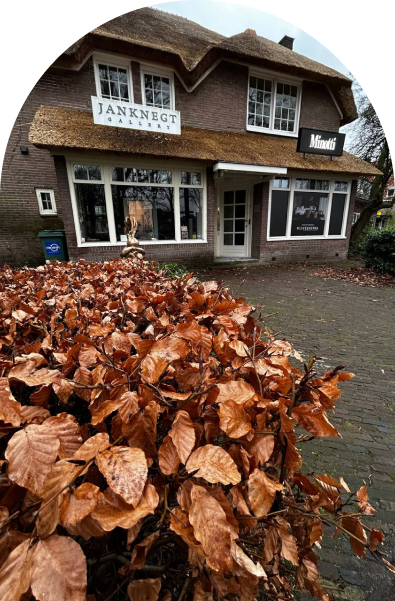
But let's not get ahead of ourselves.
After establishing himself among the elite hairdressers of Paris, World War I broke out on August 4, 1914. My grandfather was 31 years old, but he was called to arms to defend Belgium and had to take his place in the Flemish trenches.
However, on October 10, 1914, the fortress city of Antwerp fell, and along with around a million civilian refugees, more than 40,000 Belgian soldiers, including my grandfather Maurice, fled to neutral Netherlands to avoid capture by the enemy.
Maurice ended up in an internment
However, on October 10, 1914, the fortress city of Antwerp fell, and along with around a million civilian refugees, more than 40,000 Belgian soldiers, including my grandfather Maurice, fled to neutral Netherlands to avoid capture by the enemy.
Maurice ended up in an internment
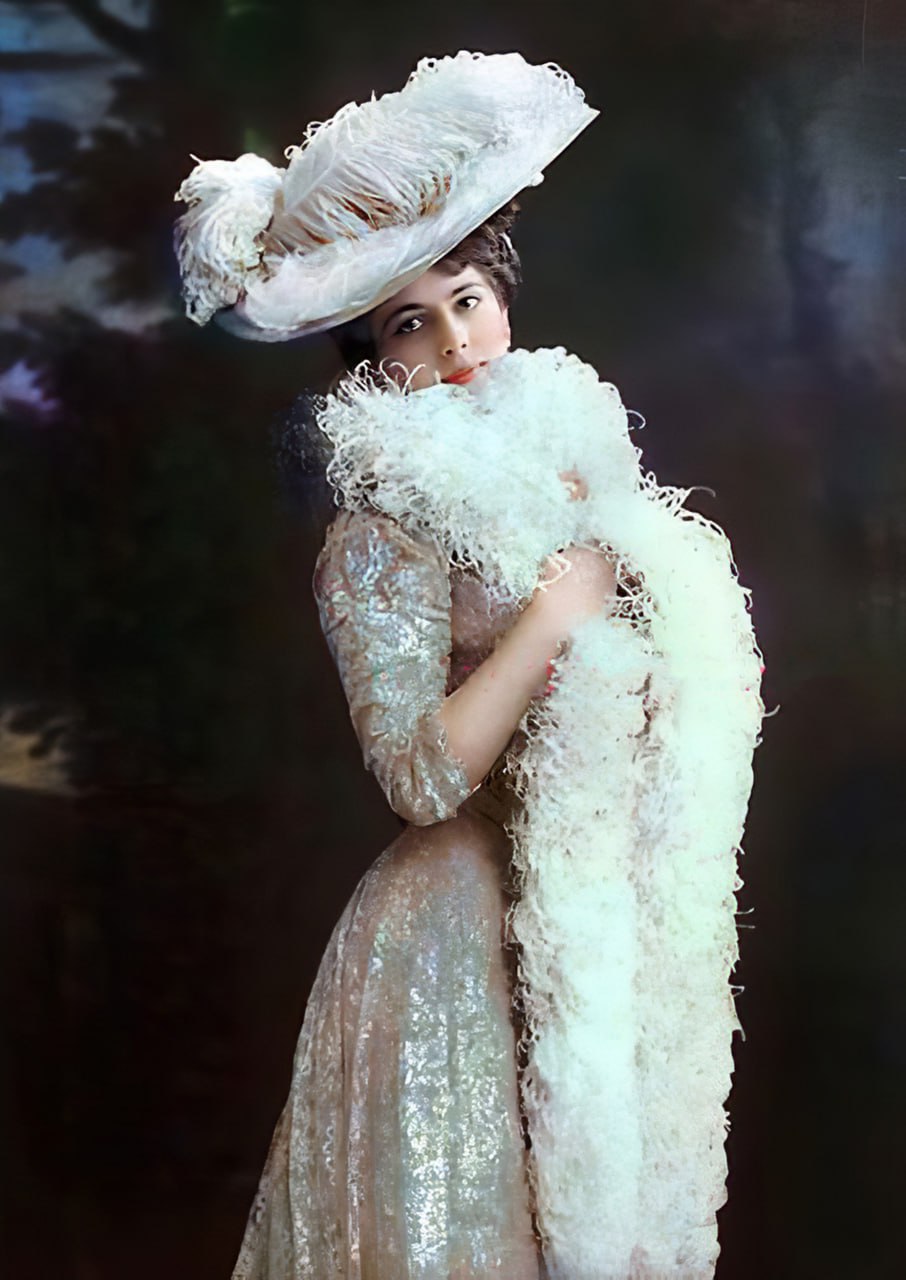
In 1917, during the early years of World War I, when Maurice was 34 years old, he established his own business, Maison Maurice, coiffeur de Paris, in Amsterdam. Around 1919, a young girl with stunning black hair reportedly came to him as an apprentice. She would later become his wife: Henriette van den Dobbelsteen.
He had recovered and built back a life for himself.
The salon was a huge success. The reputation of “the French hairdresser” was well-established, and people travelled from near and far to visit Maison Maurice, the salon where everything was dedicated to the craft and its creations, and where Maurice spoke of it poetically. To this day, in Laren, at the threshold of our family salon, there is a memorial plaque with verses by the renowned poet Annie M.G. Schmidt dedicated to my grandfather.
He had recovered and built back a life for himself.
The salon was a huge success. The reputation of “the French hairdresser” was well-established, and people travelled from near and far to visit Maison Maurice, the salon where everything was dedicated to the craft and its creations, and where Maurice spoke of it poetically. To this day, in Laren, at the threshold of our family salon, there is a memorial plaque with verses by the renowned poet Annie M.G. Schmidt dedicated to my grandfather.
“French Hairdresser” in Netherlands
Later, during the Second World War, his business suffered again as he faced many hardships, but he never gave up. He survived and continued to work until he retired at the age of 76.
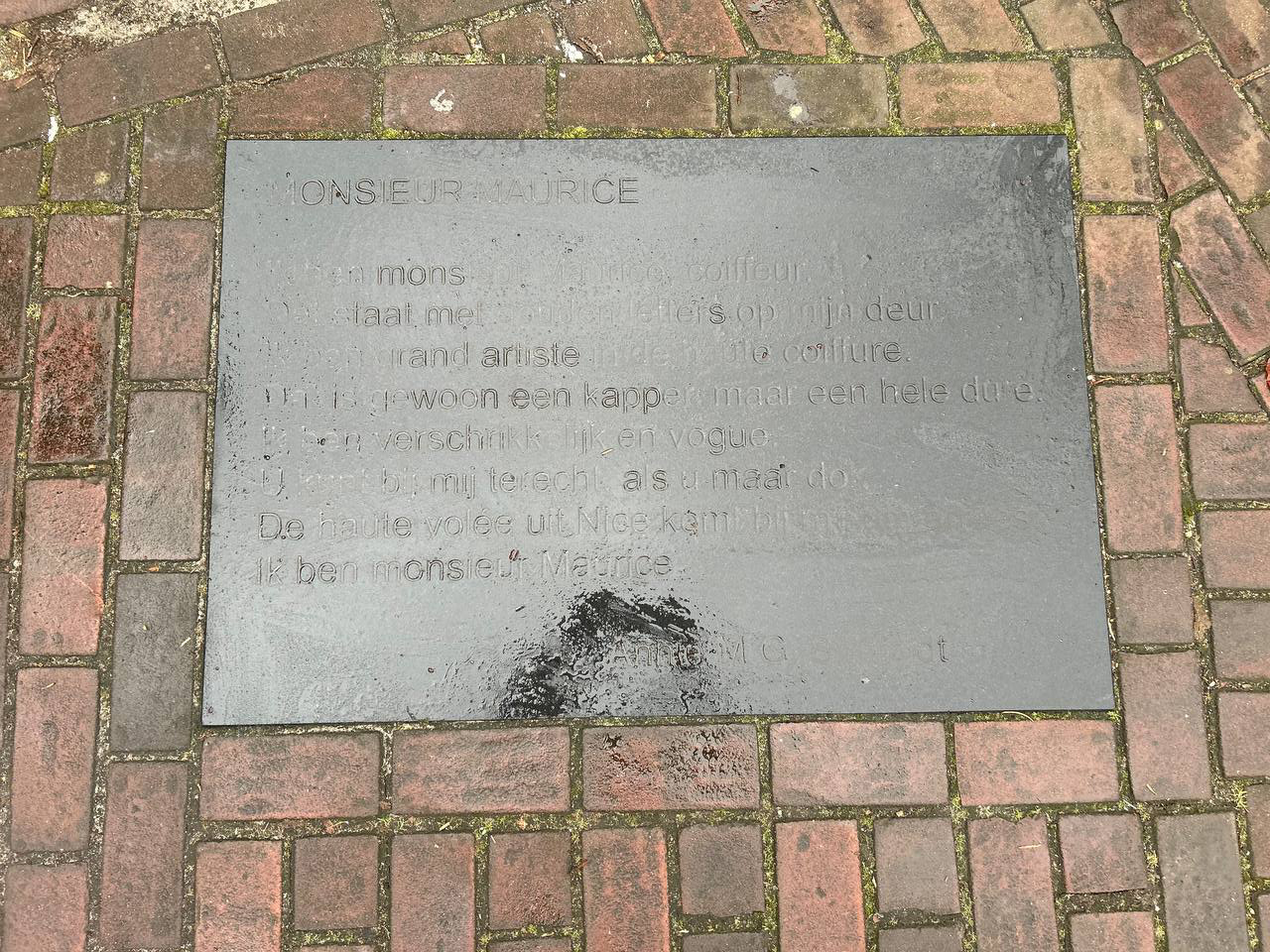
This was the greatest time for my creativity. It was so intense that, much like Bruno Pittini (Jacques Dessange's Art Director), who had been my idol in my younger years, I became a trendsetter for many Dutch hairdressers, inspiring them to invent their own styles.
I introduced a new approach that embraced freedom, fluidity, naturalness, and simplicity. Back then, styles were rigid, overly formal, and impractical for everyday wear.
In my shows for hairdressers, I demonstrated cutting techniques that allowed hair to fall naturally and adapt to various styles. Encouraging my peers to explore their creativity, I showcased the cuts that people could easily manage themselves. It was a decisive moment for the Dutch beauty industry, an important shift from craft to artistry, from overly technical approaches to flexibility.
I think it's something many in the industry still appreciate.
I introduced a new approach that embraced freedom, fluidity, naturalness, and simplicity. Back then, styles were rigid, overly formal, and impractical for everyday wear.
In my shows for hairdressers, I demonstrated cutting techniques that allowed hair to fall naturally and adapt to various styles. Encouraging my peers to explore their creativity, I showcased the cuts that people could easily manage themselves. It was a decisive moment for the Dutch beauty industry, an important shift from craft to artistry, from overly technical approaches to flexibility.
I think it's something many in the industry still appreciate.
Now, every day, I focus on my mission: making people happy with a new hairstyle. One that falls as naturally as possible and is elegant but simple at the same time. Love is in the hair is my moto. I seek inner beauty.
For me, cutting is really a form of art. Once I see a person, we begin talking. I take a moment to observe them and think, “let them tell me who they are, what they strive for, and what their mood is.” As I wash their hair, I may ask myself, “how shall I approach this?”
I respond to myself and just go for it. I trust my experience and let it guide me by feeling. It’s important that my customers respond to me with the same trust.
This is where the creation begins — I delve “into the hair” and I follow my intuition to discover the most beautiful things. And as I keep looking in the mirror, I stay connected with my customer. I’m constantly immersed in the movement of the hair and the sensation of my hands in it. It’s like a dance between partners.
For me, cutting is really a form of art. Once I see a person, we begin talking. I take a moment to observe them and think, “let them tell me who they are, what they strive for, and what their mood is.” As I wash their hair, I may ask myself, “how shall I approach this?”
I respond to myself and just go for it. I trust my experience and let it guide me by feeling. It’s important that my customers respond to me with the same trust.
This is where the creation begins — I delve “into the hair” and I follow my intuition to discover the most beautiful things. And as I keep looking in the mirror, I stay connected with my customer. I’m constantly immersed in the movement of the hair and the sensation of my hands in it. It’s like a dance between partners.
Making People Happy with a New Hairstyle
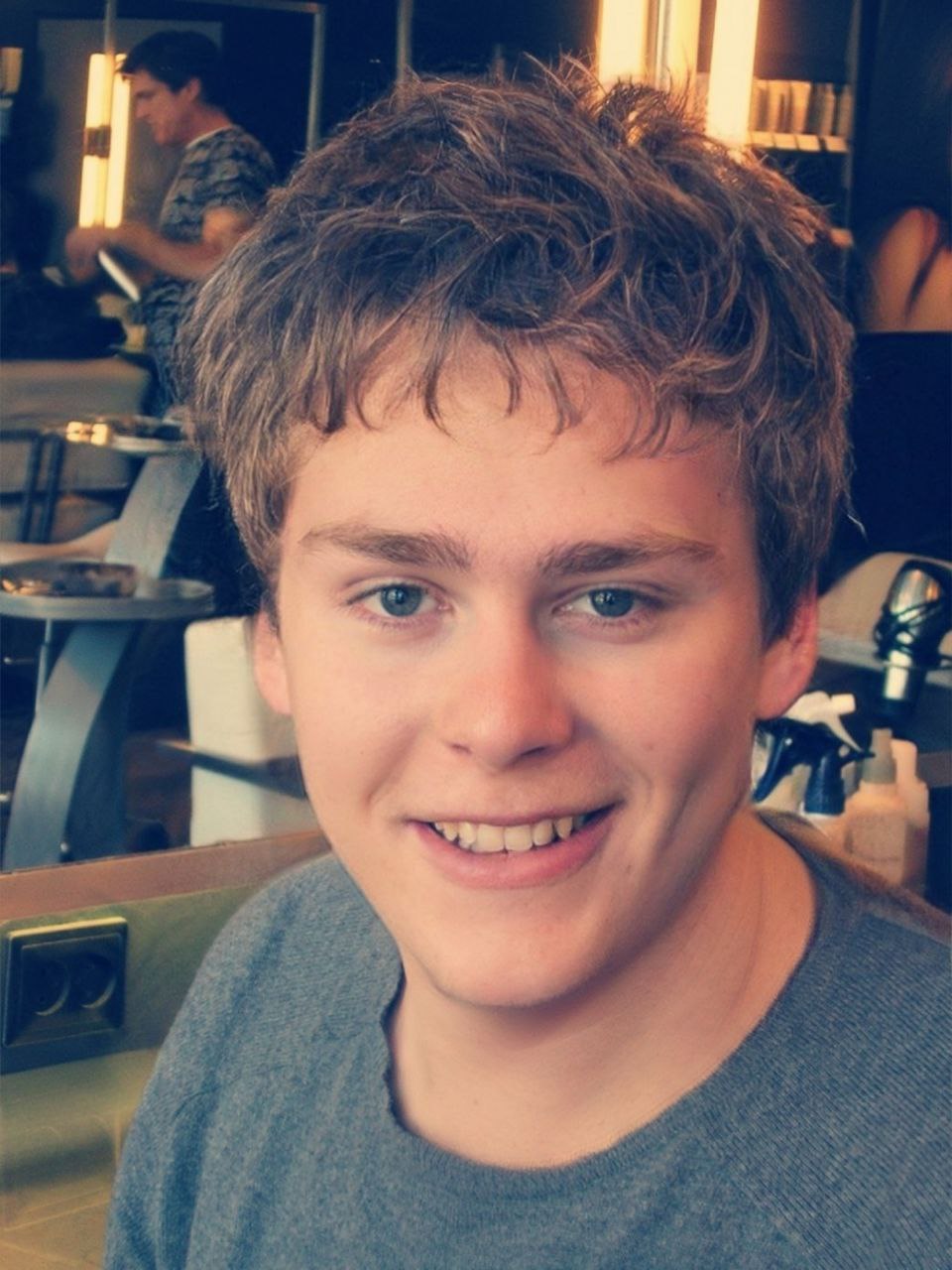
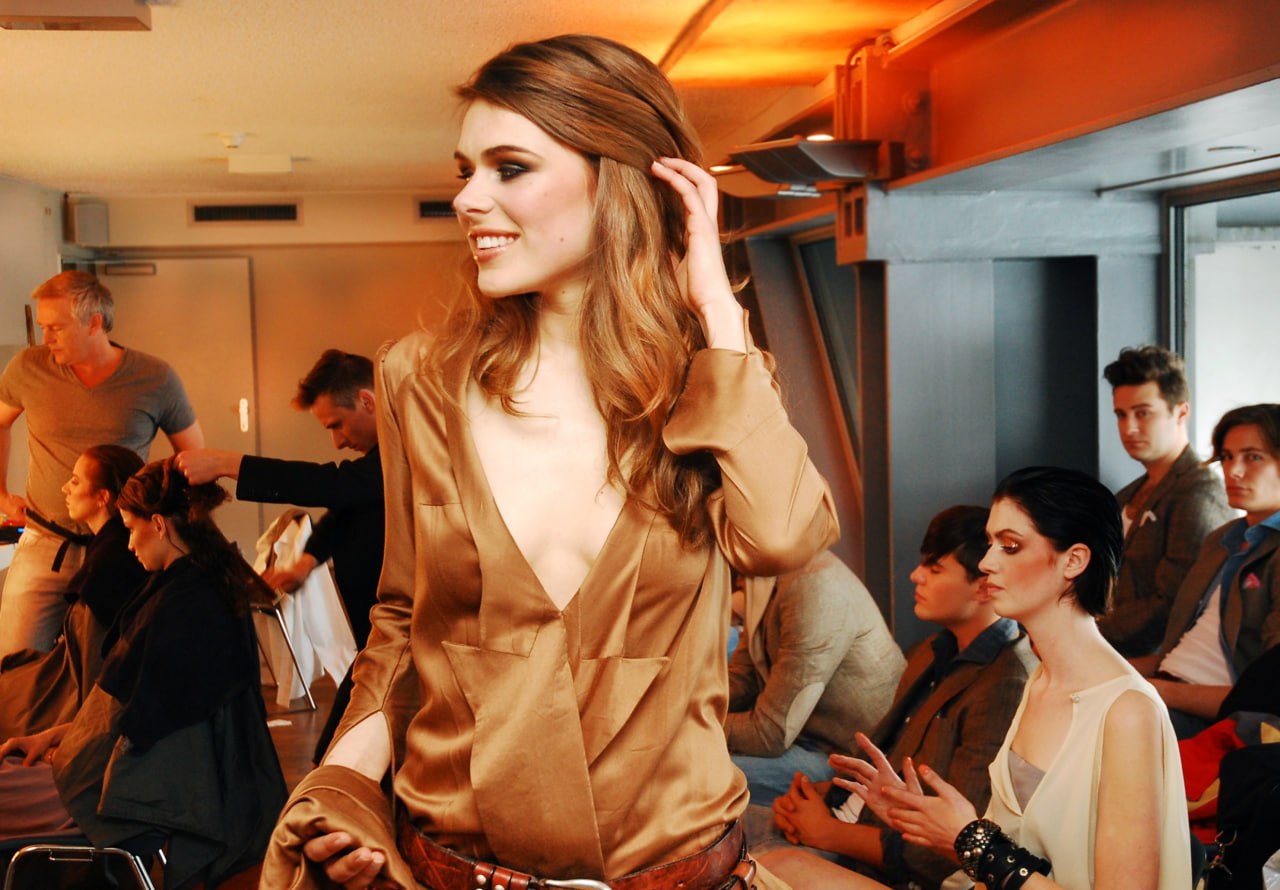
I don’t hesitate about the technique, cutting two or three or four centimetres shorter doesn’t matter — it’s about the shape, not the length. It’s like a roller coaster of creation, where you’re constantly making and building things up so that they end up harmoniously connected. It often results in something that excites me— you think goed gedaan (“well-done” in Dutch), it’s a piece of art — that’s why I’ve been in this profession for so long, it continues to excite me and bring me joy.
This is my life, the love that I will never lose. I know I will die with a pair of scissors in my hands.
This is my life, the love that I will never lose. I know I will die with a pair of scissors in my hands.
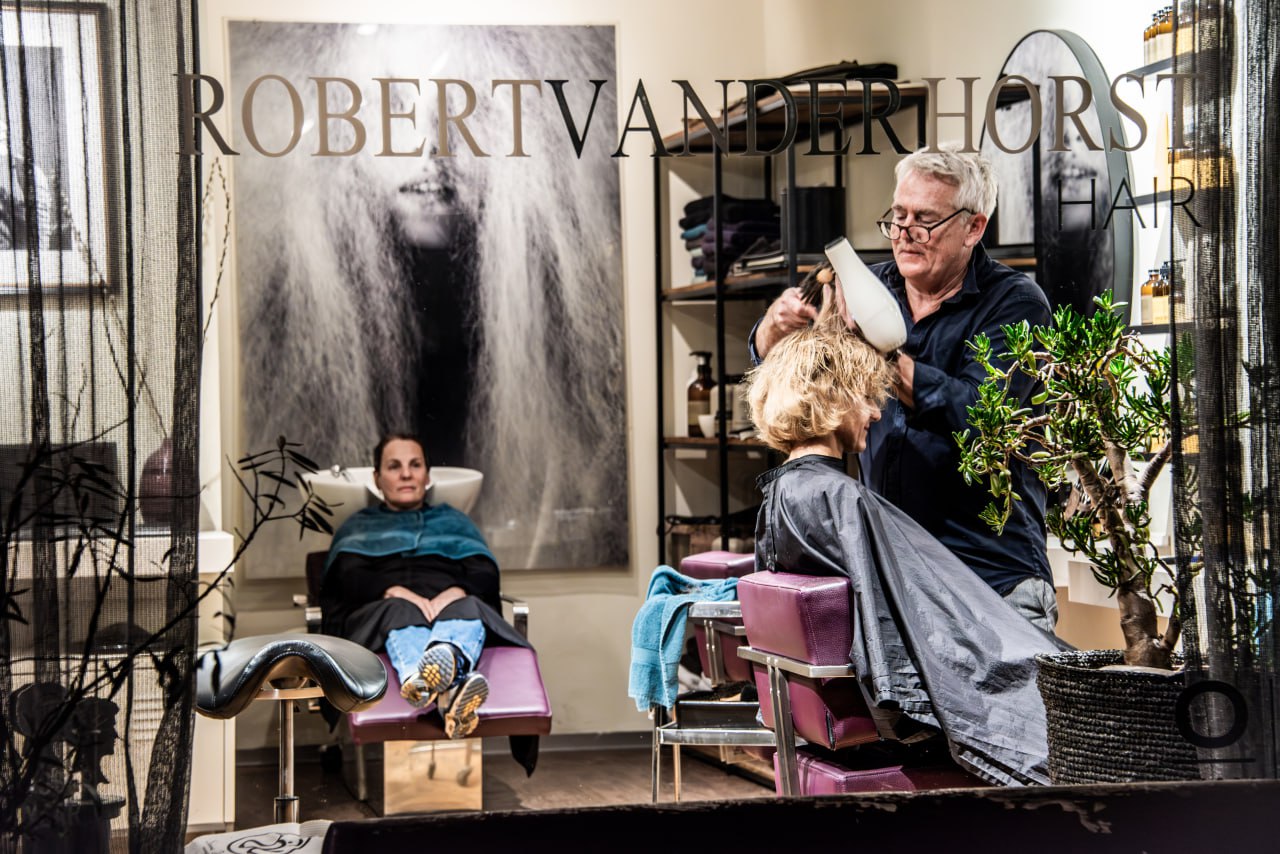
After two years working under my uncle, I left Laren for Amsterdam.
I worked at the Bijenkorf salon and later at a colleague's establishment. We were in the middle of the city, opposite Hotel De L'Europe. I met many customers there, including a famous fashion model. Through her, I entered the fashion world. That's how I gained more hairstyling experience and expanded my portfolio.
I worked at the Bijenkorf salon and later at a colleague's establishment. We were in the middle of the city, opposite Hotel De L'Europe. I met many customers there, including a famous fashion model. Through her, I entered the fashion world. That's how I gained more hairstyling experience and expanded my portfolio.
On My Own
By the time I was 28, I opened my first salon at 143 Prins Hendrikkade. It was on the first floor. When you looked out the window, you could see the unique prow of the NEMO Science Museum across the shimmering water. It’s beautiful!
Back then I couldn’t afford both a business and a house. So, I actually lived in the back of the store.
It was during that time I decided to compete for the Hairdresser of the Year title.
Thousands of hairdressers participated — I had no idea it was that big when I signed up. Against all expectations, I won!
It still amazes me that success can come from doing what you love, with passion and dedication. I never set out to become famous or aimed to be Hairdresser of the Year. I simply did what I enjoyed in a way I believed was right. One day, I woke up to find myself in the Hall of Fame Coiffure Award, having been honoured three times as Hairdresser of the Year in the Netherlands.
This began a golden period for my career. I welcomed more and more customers, expanded the business, and hired a few people. Dutch celebrities started coming in more often — Herman Brood once said to me: “We are both artists.” I will never forget that.
Back then I couldn’t afford both a business and a house. So, I actually lived in the back of the store.
It was during that time I decided to compete for the Hairdresser of the Year title.
Thousands of hairdressers participated — I had no idea it was that big when I signed up. Against all expectations, I won!
It still amazes me that success can come from doing what you love, with passion and dedication. I never set out to become famous or aimed to be Hairdresser of the Year. I simply did what I enjoyed in a way I believed was right. One day, I woke up to find myself in the Hall of Fame Coiffure Award, having been honoured three times as Hairdresser of the Year in the Netherlands.
This began a golden period for my career. I welcomed more and more customers, expanded the business, and hired a few people. Dutch celebrities started coming in more often — Herman Brood once said to me: “We are both artists.” I will never forget that.
I stood in the doorway; Uncle Henri couldn't see me, but I was observing his hands, their graceful movements, giving life to a new image.
Suddenly, I felt as if someone gently hugged me on the shoulder and said, “You must do this!” It was that magical moment that changed my life. That's how I found my true passion and became a hairdresser.
I began an apprenticeship with Uncle Henri. I carefully observed everything he did and also practised on my friends at home.
Every year, Henri went to Paris to attend hairdressing shows where live cutting was done on stage. I went with him, and I loved it. In hairdressing school, you learn technical cutting, but during those shows, they cut mostly based on feeling.
Suddenly, I felt as if someone gently hugged me on the shoulder and said, “You must do this!” It was that magical moment that changed my life. That's how I found my true passion and became a hairdresser.
I began an apprenticeship with Uncle Henri. I carefully observed everything he did and also practised on my friends at home.
Every year, Henri went to Paris to attend hairdressing shows where live cutting was done on stage. I went with him, and I loved it. In hairdressing school, you learn technical cutting, but during those shows, they cut mostly based on feeling.
Call it a Miracle…or Destiny
Like a lot of young boys growing up in the Netherlands, I dreamed of becoming a professional footballer. I was a goalkeeper in the Ajax youth team.
One day when I was 17, I happened to visit our family hairdressing salon in Laren. At that time, my Uncle Henri was in charge. I stopped by to borrow a few guilders for a quick trip to the shooting range.
I don’t remember much about the shooting range, but I remember what I saw that day in the salon.
One day when I was 17, I happened to visit our family hairdressing salon in Laren. At that time, my Uncle Henri was in charge. I stopped by to borrow a few guilders for a quick trip to the shooting range.
I don’t remember much about the shooting range, but I remember what I saw that day in the salon.
Contacts
Menu

© 2024 Robert Van Der Horst
Eerste Bloemdwarsstraat 19, 1016 KR Amsterdam

020 626 6288
06 53 25 25 99

haarstudio@robertvanderhorst.nl




